#Scala Programming
Explore tagged Tumblr posts
Text
/* Filename: Discipline.scala */ for (i <- 1 to 1000) { println( f"$i%4d: I will not use code to cheat." ); } // >:3
#computer programming#open source software#software#computer science#development#free software#software development#software developers#programming#scala#scala programming
50 notes
·
View notes
Text
issuu
Scala's unique features, performance, and actively growing community support have set it apart as a dynamic choice for modern developers. This easy guide will explain to you the more reasons.
0 notes
Text
Post #176: Opinion poll by Small Basic Programming on Tumblr, Question: Which object-oriented programming language do you prefer to program with?, 2023.
#coding#programming#programmieren#education#learning#object oriented programming#python#java#c++#c#ruby#go#javascript#php#simula#smalltalk#scala#eiffel#opinion poll#survey
74 notes
·
View notes
Text
https://asadmukhtar.info/note/programming-in-scala
Introduction to Scala
Scala is a modern programming language that combines object-oriented and functional programming features.
It runs on the JVM (Java Virtual Machine), making it highly compatible with Java.
Scala is concise, expressive, and designed for scalability in software development.
#Scala#Programming#SoftwareDevelopment#ScalaProgramming#FunctionalProgramming#Java#JVM#ObjectOrientedProgramming#ScalaTutorial#Coding#Developer#SoftwareEngineering#ProgrammingLanguages#ScalaTips#ScalaDevelopment#FunctionalParadigm#ScalaSyntax#BackendDevelopment#TechTutorial#OpenSource#ScalaApp#JVMLanguages#ProgrammingBestPractices#ScalaProjects#ScalaCommunity#DeveloperTools
2 notes
·
View notes
Text
this is a fumo account now

fumo programming
7 notes
·
View notes
Text

hi!! ive been working on a minecraft server/collaborative worldbuilding project for A Long While! it’s gonna be like a Year by the time i release the public beta
civcubed is basically a collaborative sandbox to worldbuild societies in—conflicts, economy, varied natural conditions, and a lot of other forces that shape societies to be unique! i thought it would be cool to see a bunch of people building semi-realistic societies within minecraft
anyways i hope some of y’all come to check this out! >:3
#minecraft#worldbuilding#collaborative worldbuilding#roleplay#god i cant believe its almost been a year of this#shoutout to scala i love programming in it >:3#made me love the JVM#anyways i think it would be cool if some people joined!#described
20 notes
·
View notes
Video
youtube
SQL - How to Use Qualify Clause
0 notes
Text
Upgrade your programming skills with up to 15 books on Java, Kotlin, Scala, and more!
Upgrade your programming skills with up to 15 books on Java, Kotlin, Scala, and more! #sale #java #kotlin #scala #programming #coding #sre #book #books #education #learning
Use this link to check out the three bundle options with up to 15 books! Add one of the most popular programming languages to your coding repertoire with this bundle of books on all things Java from O’Reilly! You’ll get a host of books on this powerful and versatile language, like A Functional Approach to Java, which will bring you up to speed on the essential concepts and practices of the…

View On WordPress
1 note
·
View note
Text
#learn#free#resource#python#r#postgresql#chatgpt#tableau#power bi#excel#scala#apache spark#shell#git#oracle#programming#software
0 notes
Text
If you enjoy Scrabble and want a quick and easy way to tally up the score on words, Scorble is for you! To use it:
Make sure you have Java installed on your computer.
Go to Releases at the link above and download the latest copy of scorble.jar (currently 0.2.1)
If you're using Windows, download scorble.bat as well and put it in the same folder. You can then double-click it to run the program. (If Windows warns you that they don't recognize the program, click "More info" then "Run anyway")
If you're on macOS or Linux, download the plain scorble file. You will then need to open Terminal, navigate to the folder containing scorble and scorble.bat, and type ./scorble to run it.
#scrabble#board games#programming#computer programming#development#java programming#scala#open source software#open source#foss
0 notes
Text
That feel when you made a compiler before for college...in SCALA AHHHH!!
There are three projects that I consider some of the hardest in computer science:
Compiler - Requires tons of text parsing, type system configuration, and code generation. A conglomerate of data flow.
Operating system - Build everything from the ground up. You don't even start with an allocator. Implement. Everything.
Browser - So many standards need to be implemented, it's a feat of graphics programming. Just the SVG specification is 900 pages.
If I'm missing anything on that same level of difficulty, let me know.
#scala#programming#women in stem#software engineer#engineering#female engineer#compiler#computer science#computer stuff#software#technology#systems
107 notes
·
View notes
Text
Coralie Fargeat, director
His films opened gates towards imagination. Towards an endless mental space where each could project its own inner world. We could wander in his films. Go back to them again and again. They were thick with secrets, with the unexplained. They were full of the unnecessary.
That was so essential. It requires a lot of strength: the deliberate act of creating worlds with no boundaries. To create paths where our mind can follow its own way. Carpets. Back yards. Heavy rooms. Roads. A whole unseen world was infusing behind each of those spaces. They were becoming open spaces for our imagination. I loved his work for that.
Paul Schrader, director
David couldn’t get Blue Velvet made. Dino De Laurentiis told David he’d pay me to rewrite the script and David gave it to me. It was one of the best scripts I’d ever read. I told Dino there was no way I could improve it. David thanked me and Dino financed the film. The rest is film history. The only thing to add is this: smoking kills.
Stephen Woolley, programmer and producer
When I finally caught up with Eraserheead, I was so mesmerised and besotted with its beautiful design, disturbing imagery and surreal humour that I programmed it for two months exclusively at the Scala cinema in London. It was one of the most important films I had ever seen and still is.
He came for the opening. But, looking at the programme, he appeared suddenly alarmed (his expressions usually vacillated between open-faced exuberance and intense curiosity). I asked what was wrong. He apologetically explained in what can only be described as a Jimmy Stewart drawl that there was a mistake: it said the film was playing during the day. He went on to explain: nobody watched it in daylight; it was a midnight movie; it would flop at 3pm.
Ironically, Lynch liked to describe Eraserhead as his Philadelphia Story – not the charming romcom with Stewart, Hepburn and Grant, but a tale inspired by his time living in the most violent and crime-ridden neighbourhoods in the city. He had lived all over the US, after being born in Montana, but kept that adorable, sing-song midwest accent throughout his life.
I told him there was no mistake – and happily David was wrong. Eraserhead is a transgressive and pleasurable enigma, existing alongside movies like Tod Browning’s Freaks, Buñuel’s Un Chien Andalou and Jodorowsky’s El Topo – as a masterpiece of grotesquery as beauty – like a Francis Bacon painting or a Louise Bourgeois sculpture.
Peter Strickland, director
I first saw Eraserhead at the Scala cinema on Saturday 10 February 1990 and to say it was an influence is an understatement. It pointed to an aesthetic pathway hitherto hidden from view, and most tellingly, as with many altering experiences, it revealed something within me that was probably always latent, but required unveiling.
At one point I fell asleep. But my dream state was porous enough to allow in fragments from the film, such as the Lady in the Radiator song, which made the whole experience even more indelible.
For all the genuinely repellent scenes in Eraserhead, the film’s ignition is in its confoundingly wayward tonality and how Lynch saw and heard the world. It was the first time I considered sound as something expressive rather than illustrative and considered film as something impressionistic rather than representative. The film functioned as an environment more than anything. I kidded myself that I could live in that inner world, though my only concession to that was in purchasing the film’s poster from a shop in Reading called But Is it Art?.
Carol Morley, director
It’s hard to believe Lynch has gone, but incredible to contemplate all that he did, and just how his avant garde art bravely made it out into the big wide world and continues to thrive. His film-making turned everything upside down and inside out and he did it with such originality it was breathtaking. He didn’t analyse. He felt, he had dreams and he tried to catch something in the air. In the book Lynch on Lynch, he said: “There are things that cinema can do that are very difficult to talk about.” He understood the mystery and magic like nobody else.
The best thing in the world for him was to have an idea. And he inspired me to stay true to my own ideas even when navigating the tricky and sometimes suffocating parts of film-making that are essentially commerce above art. Over the years I’ve watched and read interviews with him, and once spent a morning in bed reading his insights into life and creativity in his alternative self-help book, Catching the Big Fish. I’d begun the day never wanting to get up again and certainly never wanting to make a film again, but he returned my desire to do both. And through this, he taught me to hang on to the personal, to always return to the beginning of a process – to remember what you fell in love with when you had the initial thoughts and to never let go of that feeling and to keep going deep.
Lynch dreamed up his films – literally. The ending of Blue Velvet came to him in a dream. He inspired me to connect with my unconscious, to pay it respect. I loved how he explored the unmentionables in life, shone light into darkness, created monsters and outsiders, how he reconciled opposites such as the innocence and horror of small-town America, how he looked at “the weird on top” (as Laura Dern’s character in Wild at Heart says) and then took us underground.
The original Blue Velvet trailer says: “It will open your eyes to a world you’ve never seen before.” That pretty much sums up all of Lynch’s oeuvre. There’s a familiarity, but then again ��� I was around when Twin Peaks aired on TV in 1990 and my friends and I couldn’t stop talking about it. We began to see things differently. Life became Lynchian. I swear he altered the structure of our brains.
His work has always been a great challenge for the mind, but it’s the emotion in his films that has kept me returning for clues. As inventive as he was with performance, image, sound and music, nothing he did was embellishment for the sake of style, everything Lynch did was in service to the story. And It’s clear how much he loved his actors, how he gave them a safe and freeing space to do the very delicate and personal work actors have to do.
Alice Lowe, director
Many remember the first time they encountered Lynch’s indelible images, heard his sound and music for the first time. To me, he’s just always been there. And that’s when a cultural loss feels hard: when you’ve not met someone, but their work feels personal to you, part of your psyche.
But what’s strange is how many feel that way. The strangeness and intimacy of his work is counterintuitive to its popularity, its sheer power to force its way into culture collectively. His work spoke its own language, but a language that was strangely universal. In a time when the very nature of film as an individual’s perspective and the human auteurship of art is in question, it feels seismic to have lost him.
He reminded us that genius can be coupled with kindness and humanity. To me his greatest collaboration was with his audience. The generosity to allow people to project their own interpretation upon his work, forging powerful bonds with it.
For me it is the power of colour within his work; the soul-shifting nature of the sound design; his unforgettable characters: Bob crawling over the sofa, Diane Ladd covering herself with lipstick, Nicolas Cage’s sweetness in Wild at Heart, the log lady, the lady in the radiator, The Elephant Man choosing to die. He deftly mixed tones – nigh impossible. Humour and darkness and horror and sadness and wonder. All human experience contained.
He was the best magician. His spell was to dispel accusations of elitism or pretension with the sheer primality of his incantations. It is happening again. You may not be able to explain it, but deep down, you understand it. Universal. He showed us monsters without being a monster. And his showmanship was filled with empathy.
I’m going try to find something in the wreckage of this loss: a promise to be creative, to trust in art, in humanity, that there is a collectivity to our experience, and it’s worth sharing it. I hope his family are comforted by the love pouring out for this wonderful human.
39 notes
·
View notes
Note
Which ballet companies and which ballet schools you consider to be currently world best? I see often Paris Opera listed as a number one, but who much this is about because of its reputation and history and what do you think about Mariinsky and Bolshoi, is their level declined / declining? Thank you for really interesting and great blog!
The companies referred to as the best tend to be the oldest and historic ones, think big national companies like The Royal Ballet, Paris Opera, Bolshoi, Mariinsky, La Scala, Dutch National Ballet, Australian National Ballet, National Ballet of Canada, New York City Ballet, American Ballet Theater, San Francisco Ballet. Nowadays, I think its very hard to compete with the quality, emotional pull, and technical brilliance that comes out of the Royal Opera.
About Schools:
There are lots of good ones, Academie Princess Grace has to be near the top of the list. It's a finishing school, not a foundational one, but nearly everyone who graduates from there gets a job at a reputable company. They are also one of the few schools that has prioritized keeping its curriculum at the forefront of the dance world with a fantastic contemporary and neoclassical program.
I'm consistently impressed with the level of Royal Ballet graduates who have the skills and stability to rock up to any company and instantly demand attention. Look at Takumi Miyaki at ABT right now.
The level of talent coming out of South Korea in particular is absolutely stunning, schools like SunHwa, the YeWon School, and Korea National Arts University are producing complete, company-ready dancers left and right. Through the competition circuit, these schools are slowly starting to gain more international prestige.
I think BBA/MRAX has been in a state of disarray for a while now. Far less competent graduates, due to a lot of internal messiness in administration and a decrease in the rigor of acceptance with many 'paid' places. The level is just not there, especially if you go back and watch videos of exams from the 90s and 2000s. Now sure, many are still getting accepted into Bolshoi, but with the war....there isn't exactly a lot of choice in hiring. There are occasionally some bright lights, Kokoreva being the most notable recent grad, but they seem to be a rarity and not the norm.
Vaganova under Tsiskaridze has generally continued to produce decent female graduates- if you want to live and work in Russia. I pray Tsiskaridze goes back to coaching or teaching boys because the classwork shown by his class of girls left a lot to be desired. I think there are many better places to train for men, particularly after the retirement of some of the older, more experienced faculty. The casting in Mariinsky is already beginning to reflect this drop-off, performances are dominated by Kimin Kim, Nikita Korneyev, and Even Capitane, Timor Askerov - none of whom are VBA graduates. They've also been hiring graduates from Eifman- something they certainly weren't doing a decade ago. Compare their current videos to some of the talented students coming out of the US, Europe and South America...the level isn't always there. I'd urge a talented male student to consider John Cranko, Tanz Academie Zurich, or the Royal Ballet School. Stateside, Houston Ballet, The Rock School, and San Francisco Ballet have excellent programs.
36 notes
·
View notes
Text
@java-official might have something to say about that...
HELLO I AM NOW SCALA THE BEST JVM LANGUAGE
#I do actually quite like functional programming sometimes#and IIRC scala allows both FP and OOP?#thats quite nice in comparison to pure OOP languages like Java or pure functional languages like Haskell#assembly official#programming#comp sci
7 notes
·
View notes
Text
ANTÔNIO CARLOS GOMES
@princesssarisa @themousefromfantasyland @obufalo @the-blue-fairie @tamisdava2 @moonbeamlightning
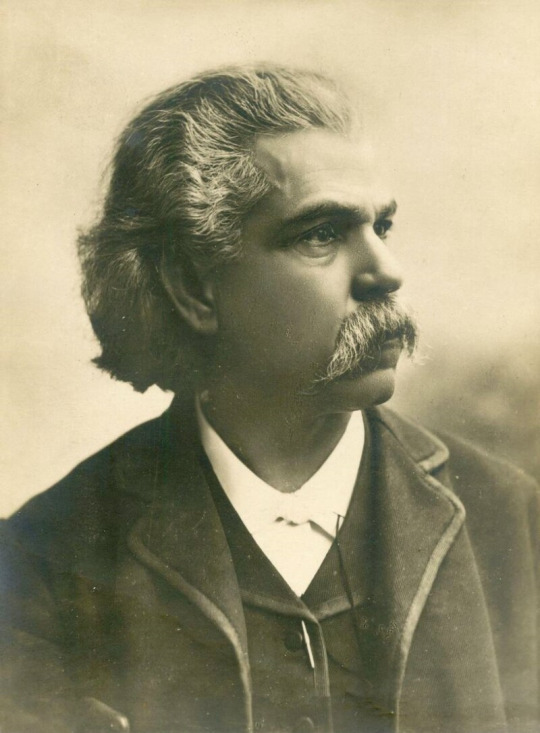
Antônio Carlos Gomes was born in Campinas on 11 July, 1836, and from an early age, he showed an interest in music, encouraged by his father, Manuel José Gomes, who was also a musician. As a young man, he divided his time between working as a tailor and studying music.
youtube
At the age of 15, he began composing waltzes, polkas, and quadrilles. By the time he turned 18, he had gained recognition with the composition of his first mass, the Missa de São Sebastião.
youtube
This work, that he dedicated to his father, was imbued with mysticism.
In 1857, he released A Cayumba, one of the first classical pieces to incorporate rhythms from African dances into the structure of a ballroom polka.
When he was still young, he moved to Rio de Janeiro to study at the Imperial Conservatory of Music, where he was mentored by renowned masters such as Francisco Manuel da Silva, the composer of the Brazilian National Anthem.
In 1861, he premiered his first major work, A Noite do Castelo, at the Lyrico Fluminense Theater, based on the work of Antônio Feliciano de Castilho.
Carlos Gomes was acclaimed by an enthusiastic crowd, and Emperor Dom Pedro II, also impressed by the young composer’s success, honored him with the Imperial Order of the Rose.
Carlos Gomes’s talent quickly captivated the court. In 1863, he presented his second opera, Joana de Flandres, with a libretto by Salvador de Mendonça, which also achieved great success.
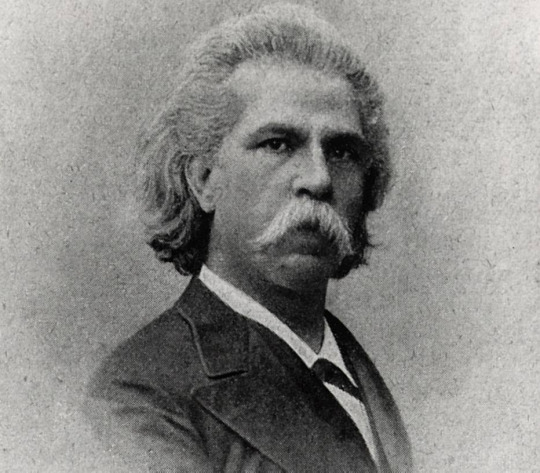
In recognition of his talent, he was selected to receive a scholarship to study in Europe, funded by the National Lyric Opera Company as part of a contract with the Imperial Government.
It is said that Dom Pedro II would have preferred Carlos Gomes to study in Germany, where the maestro, Richard Wagner was prominent, but the Empress, Dona Teresa Cristina, a Neapolitan, suggested Italy instead.
Under Pedro II’s patronage, he was admitted to the Milan Conservatory, where, in 1866, he graduated as a master and composer, earning the highest praise from critics and professors alike.
He lived in Milan, but he never forgot Brazil. He was looking for inspiration for a work that would firmly establish his reputation when one afternoon in 1867, while walking through Piazza del Duomo, he heard a boy shouting, “Il Guarany! Il Guarany! Storia interessante dei selvaggi del Brasile!”
The poor Italian translation of José de Alencar’s novel piqued the maestro’s interest and at that moment, the idea for his most famous work was born.
The libretto, in Italian, was written by Antonio Scalvini and Carlo D’Ormeville. The opera is important as it was the first Brazilian opera to be acclaimed outside Brazil.
O Guarani is revered for its rich orchestration, inspired melodies, and integration of elements of Brazilian Indigenous music, solidifying its reputation as a unique work in the operatic repertoire.
The opera followed a contemporary trend in Europe of curiosity about foreign peoples and customs.
O Guarani premiered at Teatro Alla Scala in Milan in 1870. Giuseppe Verdi, who had been an inspiration to the young Carlos Gomes, is said to have remarked that evening: “Questo giovane comincia dove finisco io!” (“This young man begins where I leave off!”). Its overture was later used as the theme for the radio program A Voz do Brasil.
youtube
After the end of the Monarchy, the government of the newly established Republic offered Carlos Gomes the sum of 20,000 réis to compose a new national anthem. However, the maestro refused out of respect for the deposed emperor, his friend and patron, who was in exile at that time.
In April 1896, already gravely ill, Carlos Gomes returned to Brazil and took up the role of director at the Carlos Gomes Conservatory in Belém do Pará. He passed away shortly afterwards, on 16 September.
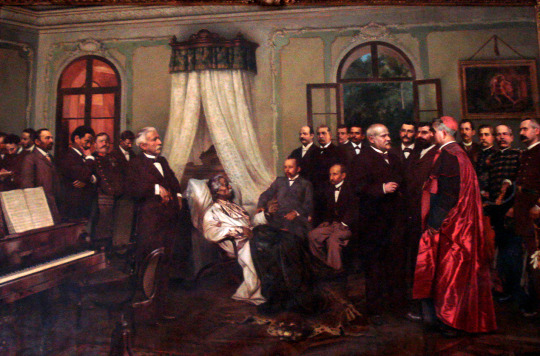
The maestro is the patron of seat number 15 at the Brazilian Academy of Music and his name was inscribed in the Livro dos Heróis e Heroínas da Pátria on 26 December, 2017.
Carlos Gomes’s legacy was recognized by UNESCO in 2017 when his work was included in the International Register of the Memory of the World (MOW) Program. For all these reasons, Carlos Gomes is one of the most honored musicians in Brazil.
youtube
In 1959, at the suggestion of the baritone, Paulo Fortes, a proposal was put forward to place a statue of Brazilian composer Carlos Gomes in front of the Rio do Janeiro Municipal Theater, replacing the statue of Frédéric Chopin, which had been placed there in 1939.
The monument was intended to mark the beginning of the 1960 national opera season. The statue was unveiled on 16 January, 1960 and was funded by the Secretariat of Transportation and Public Works of the Federal District and installed by the engineer, Elsa Osborne.
The monument is a replica of a statue created by Rodolfo Bernardelli and installed in Largo do Carmo in Campinas, the maestro’s hometown. Bernardelli depicted Carlos Gomes at the end of a performance, signaling the orchestra to be silent for the audience to applaud.
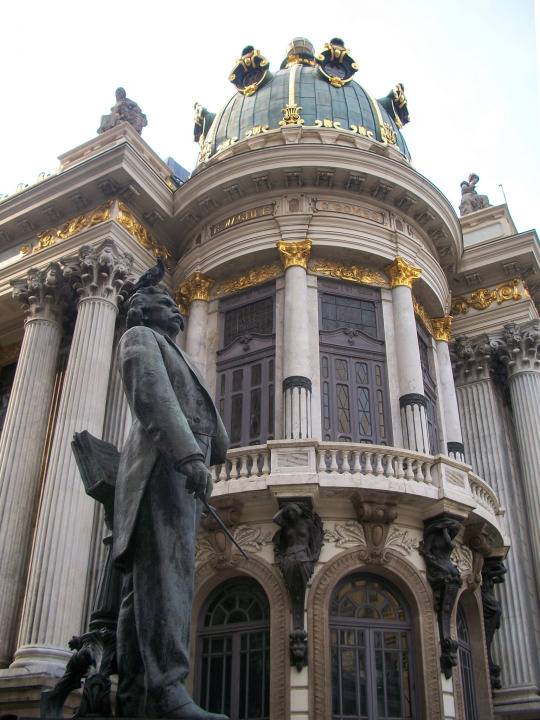
Interestingly, inside the Municipal Theater, there is a bronze bust of Carlos Gomes, also sculpted by Bernardelli.
It is in the hall leading to the first-floor seating area. There is another bust in his honor on Paquetá Island, as well as a theater named after him located in Praça Tiradentes.
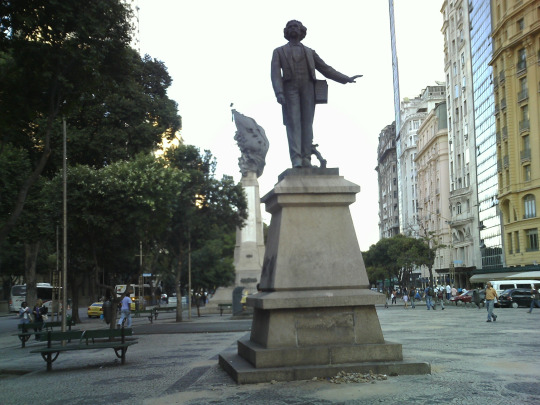
The location of Carlos Gomes’s statue in Cinelândia, an iconic center of cultural life in Rio de Janeiro, emphasizes the impact of his work, the significance of his contribution to Brazilian culture, and his recognition both in Brazil and abroad.
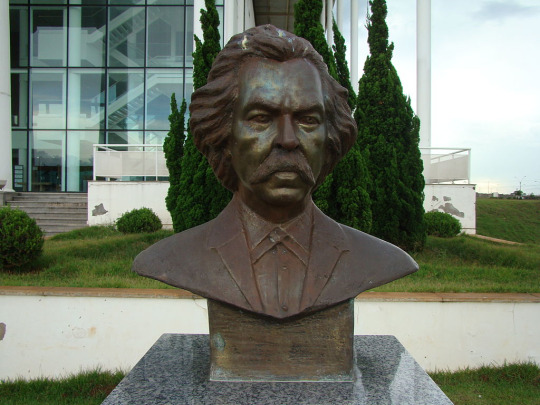
7 notes
·
View notes
Text
thinking about how Scala is the name of a programming language that was designed to express common programming patterns concisely and grow with the demands of its users and how I know literally nothing about programming to be able to form any kind of point out of this information aside from saying that this probably means something
48 notes
·
View notes